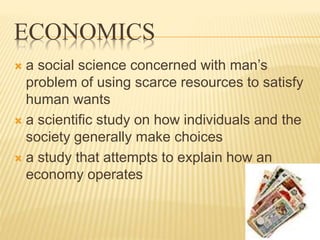
Lecture 1 eco principles
- 1. ECONOMICS a social science concerned with man’s problem of using scarce resources to satisfy human wants a scientific study on how individuals and the society generally make choices a study that attempts to explain how an economy operates
- 2. 3 Es IN ECONOMICS - EFFICIENCY - EQUITY - EFFECTIVENESS Need. A human need is a state of felt deprivation. Examples include the need for food, clothing, warmth and safety. Wants. Wants are how people communicate their needs (expressed need). A hungry person may want a hamburger, noodles, or cheese and bread. Demands. Wants backed by buying/purchasing power.
- 3. SCARCITY. (the limitations that exist in obtaining all the goods and services that people want) LIMITED RESOURCES VS UNLIMITED WANTS Opportunity Cost - The value given up for choosing an alternative
- 4. FOUR BASIC ECONOMIC QUESTIONS What to produce? How to produce? How much to produce? For whom to produce?
- 5. TOOLS OF ECONOMICS Logic. It pertains to valid reasoning and drawing of conclusion Mathematics. It means conceptualizing and quantifying economic principles Statistics. It means describing behaviors quantitatively and testing hypothesis in making inferences
- 6. SUB-CLASSIFICATION OF ECONOMIC ANALYSIS Positive Economics. It deals with the causal relationships that exist in economics. There is no value judgment and deals with “what is” Normative Economics. It deals with the way economic relationships ought to be. Value judgments play an integral part in the ranking of possible objectives and the choice to be made among them. It deals with “what ought to be”
- 7. SCIENTIFIC APPROACH Observation Definitions and Assumptions Deductions Empirical Testing
- 8. Goods – anything that yields satisfaction to someone Economic Good - a good which is both useful and scarce Utility – (usefulness) is the ability of something to satisfy needs or wants Economic Resources - inputs used in the production of goods and services (factors of production) Land – natural resources Labor – any form of human effort Capital – man-made goods Entrepreneur – the economic good that commands price Wealth – anything of value owned Rent – payment for the use of land Wages – payment for the use of labor Interest – payment for the use of capital Profit – income of entrepreneur
- 9. CLASSIFICATION OF GOODS According to form Tangible goods Intangible goods According to use Consumer goods Capital goods According to need Essential goods Luxury goods According to means of production Manufacturing Agriculture production
- 10. TYPES OF ECONOMIC SYSTEMS TRADITIONAL ECONOMY Family or Community based Economic System that relies on custom and ritual to make its choices. Examples: Aborigines Amazon Tribes
- 11. TYPES OF ECONOMIC SYSTEMS MARKET ECONOMY Individual or Consumer based Economic System that relies on the consumption choices of consumers. Examples: *The U.S.A. *Japan Any Capitalist Economy
- 12. TYPES OF ECONOMIC SYSTEMS COMMAND ECONOMY Centrally Controlled Economy where the Government makes all decisions. Examples: Cuba China Any Communist Country or Dictatorship
- 13. TYPES OF ECONOMIC SYSTEMS MIXED ECONOMY Economic System that incorporates some Governmental involvement into a Market Based Economy. Examples: *The U.S.A. *Japan Most “Modern” Economies
- 14. MODELS OF ECONOMIC SYSTEM Capitalism. It refers to a free enterprise or laissez faire economy (no government intervention) Communism. When the government controls the economy Socialism. It is a mixture of capitalism and communism. It contains the characteristics of both capitalism and communism
- 15. STOCK AND FLOW VARIABLES Production – the use of economic resources in the creation of goods and services Employment – the use of economic resources in production Consumption – the use of economic resources Flow – a quantity measured over a particular period of time Stock – a quantity measured as of a given point in time
- 16. Monetary policy – that which affects savings, investment, and money supply Fiscal supply – that which controls taxes and government expenditures Trade policy – that which affects a country’s exports and imports Inflows – income that go inside the economy like investment, government expenditures, exports which expand the flow of goods and services Outflows – incomes that go out of the economy like savings, taxes, and imports, which constrict the flow of goods and services Multiplier – the number of times income is generated by an original inflow
- 17. THE CIRCULAR FLOW ECONOMIC MODEL